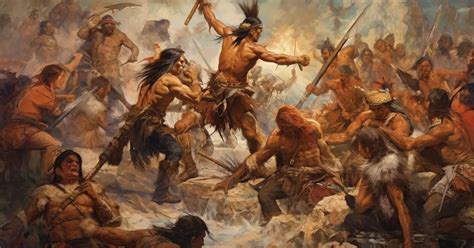Pontiac’s Rebellion was a Native American uprising that took place in the Great Lakes region of North America from 1763 to 1766. It was led by the Ottawa chief Pontiac and involved a confederation of Native American tribes who were resisting British encroachment on their lands.

Causes of Pontiac’s Rebellion
- British expansion: The British began to expand their settlements into the Great Lakes region after the French and Indian War (1754-1763). This expansion threatened the Native American tribes’ land and hunting grounds.
- British policies: The British government’s policies towards Native Americans were often harsh and unfair. For example, the British required Native Americans to sell their land to the government and to accept British laws.
- Native American grievances: The Native American tribes had a number of grievances against the British, including the loss of their land, the mistreatment of their people, and the British government’s failure to uphold its treaties with them.
Course of Pontiac’s Rebellion
Pontiac’s Rebellion began in the spring of 1763 with a series of attacks on British forts and settlements in the Great Lakes region. The Native Americans were initially successful in capturing several forts, including Fort Detroit. However, the British eventually regained control of the region and defeated the Native American uprising.
Consequences of Pontiac’s Rebellion
Pontiac’s Rebellion had a number of consequences for both Native Americans and British. For Native Americans, the rebellion resulted in the loss of land and the weakening of their power. For the British, the rebellion led to a change in their policies towards Native Americans. The British government began to recognize Native American land rights and to treat Native Americans with more respect.
Significance of Pontiac’s Rebellion
Pontiac’s Rebellion was a significant event in American history. It was the first major Native American uprising against British rule. The rebellion also had a significant impact on the course of American history, as it led to a change in British policies towards Native Americans.
- Chief Pontiac: The Ottawa chief who led Pontiac’s Rebellion
- Great Lakes region: The region of North America that includes the Great Lakes
- Native American tribes: The various tribes of Native Americans who participated in Pontiac’s Rebellion
- Pontiac’s Rebellion lasted for three years, from 1763 to 1766.
- The rebellion involved a confederation of Native American tribes, including the Ottawa, Shawnee, Delaware, and Wyandot.
- The British defeated Pontiac’s Rebellion in 1766.
- The rebellion had a significant impact on British policies towards Native Americans.
Table 1: Major Battles of Pontiac’s Rebellion
| Battle | Date | Location | Result |
|---|---|---|---|
| Siege of Fort Detroit | May 1763 | Detroit, Michigan | British victory |
| Siege of Fort Pitt | June 1763 | Pittsburgh, Pennsylvania | British victory |
| Battle of Bushy Run | August 1763 | Pennsylvania | British victory |
| Battle of Point Pleasant | October 1763 | West Virginia | British victory |
Table 2: Native American Tribes Involved in Pontiac’s Rebellion
| Tribe | Location | Population |
|---|---|---|
| Ottawa | Great Lakes region | 10,000 |
| Shawnee | Ohio River Valley | 12,000 |
| Delaware | Great Lakes region | 10,000 |
| Wyandot | Great Lakes region | 4,000 |
Table 3: British Losses in Pontiac’s Rebellion
| Type of Loss | Number |
|---|---|
| Soldiers killed | 500 |
| Civilians killed | 200 |
| Forts lost | 10 |
Table 4: Consequences of Pontiac’s Rebellion
| Consequence | Impact |
|---|---|
| Loss of Native American land | Weakened Native American power |
| Change in British policies towards Native Americans | British government began to recognize Native American land rights |
| Increased tension between Native Americans and British | Led to further conflict |
